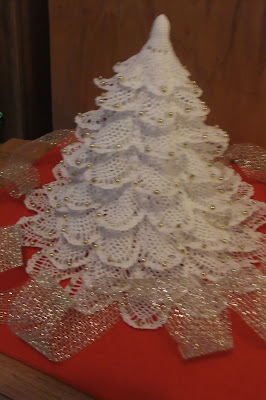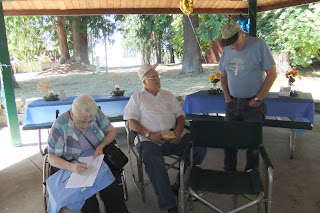On these cold, rainy November days, the ants that were so much a part of our summer landscape are tucked away snugly in their nests. They worked hard gathering food for the winter, as King Solomon mentions in his collection of proverbs, and now they are enjoying the fruits of their labors.
In my recent post
A Day on Orcas Island, I mentioned observing some wood ants. They reminded me of an incident from years ago when I was newly widowed and lived in a small RV with Sharon Dog, my red Irish setter. Part of my daily routine included taking Sharon to some nearby field or patch of woods where she could race away her abundant energy.
Near our RV park lay a tract of woodland earmarked for future development. Walking in those woods one fall day, Sharon and I came upon a hill of ants busy preparing for the winter ahead. The entire surface of the three-to-four-foot tall hill shimmered with millions of ants working together, each shiny black with a red-brown head and thorax. Along invisible trails from the woods, streams of ants carried fir needles or bits of twig to add to their hill. Some carried pieces of leaves overhead like little umbrellas or dragged insects larger than themselves to use as food. (I found out later they leave scent trails to help them find their way home.) Other ants scurried back along the same trails into the woods.
The entire hill seemed to be made of ants piled one on top of the other, but I didn't risk digging into it to find out if that was true. Though small, those ants looked unafraid of anything. Instead, I went to the Internet.
 |
| It looks like chaos, but every ant has a job to do. |
Tiny Architects
I found that wood ants often build their nests atop rotting stumps, which are easy to tunnel into. The nests, complex and wonderful constructions, are built to house hundreds of thousands of individuals. The core of each mound is covered with a deep layer of organic materials: evergreen needles, bits of twigs, dried grass, leaves, and pieces of moss and lichen. Somehow the ants know to lay the thatch in a way that intercepts the sun's rays at right angles. The thatch becomes a "solar panel," raising the temperature of the nest above that of the ambient air. This not only keeps the workers warm and active on cool days, but it also provides a warm, even temperature for the babies developing inside the nest. The thatch is also a waterproof "roof," with each needle and twig laid precisely to direct water off of and away from the nest.
Tending the Young
The center of the nest is deep underground, where workers have excavated a chamber. There, day in and day out, the queen ant goes about her business of laying eggs. The workers, all female, tend to the thousands of eggs and larva, moving them through the tunnels and chambers toward the surface or deeper into the nest to keep them at the right temperature for optimal development. They even bring them to the surface for a dose of sunshine if it is warm enough.
The Ants' Diet
Workers do more than build the nest and tend the queen and her brood. They bring in food. Ninety per cent of their diet comes from honeydew excreted by aphids. Aphids feed on plant juices, which are high in sugar. They excrete the excess sugar. Ants "milk" the aphids, collecting the honeydew in their abdomens, then return to the nest to regurgitate honeydew for the queen and other workers.
The developing larvae need protein in order to grow, so wood ants also feed on other insects such as caterpillars and beetles and even other ant species, and bring such prey in to feed the babies.
Cleanup and Security
Not only does feeding on other insects provide nutrition for the ant colony, but it helps cut down on the number of harmful insects in the environment. The ants keep the nest clean by carrying away dead workers and other debris. The workers also act as soldiers, defending the nest from predatory insects and other dangers. One type, Formica rufa, can spray formic acid at enemies up to several feet away.
 |
| Most of our Northwest Washington nests are not this large. |
After learning about all that marvelous organization and society, I wondered what would happen to the ant hill that Sharon Dog and I had seen on our walk. When we returned to the tract of former woodland that spring, we saw that the ant colony had been scraped off the surface of the earth, along with every bush, tree, and other living thing, right down to the bare gray mud. The acres were now builder-ready. The bulldozer that had shoveled away the nest left its tread marks in the dried mud. In the wasteland, we saw a half-buried piece of rotten log. From beneath it, a stream of black-and-red ants poured onto the surface. They clambered over the log, as if wondering what had happened to their nest. A trickle of ants headed across the dried mud toward a still-standing section of trees a hundred yards away. As I watched, the trickle became a steady stream.
It was not an easy journey for the ants. Crossing each lug mark left by the bulldozer meant clambering down a steep wall of mud, across the bottom, and up another steep wall...over and over again. But their path was as direct as if they followed a line laid out, and I followed along beside them. I noticed that many were carrying eggs or larvae, and some were carrying other ants. When they neared the trees, I saw that their destination was an ant hill under construction. Lines of ants fanned out in all directions from the new nest, bringing back building materials. But some of the new arrivals being carried by fellow workers evidently hadn't accepted the necessity of the move. As soon as they were released, each grabbed one of the other ants and head back toward the ruined nest!
I don't know how long it took for all the ants to be persuaded that the old nest must be vacated, but the next time Sharon and I stopped by, the new nest at the edge of the woods was much larger. And no more ants lingered at the ruins of the old.
The King James Version of Proverbs 6:6 says, “Go to the ant, thou sluggard!” The Living Bible says, “Take a lesson from the ants, you lazy fellow. Learn from their ways and be wise.”
Don’t we all wish we could be as persistent and hardworking as those wood ants?
The
big nests of the wood ants are built on the floor of the woodlands. The
withered foliage, twigs and pine needles are heaped by weaving them
collectively to make a hill that is about one meter high from the
ground. There are many thousands of compartments and tunnels that are
concealed quite a distance under the ground inside the ant mound. The
nests are similar to a town with facilities such as food stores,
accommodation facilities, linkages and also burial grounds for the ants
that die. The biggest and oldest nests accommodate as many as 100,000
ants. Generally the life of the colonies extends for several years, the
ants live underneath the ground in winter and emerge to the surface
during the spring. - See more at:
http://www.live-ants.com/wood-ants.html#sthash.fa16T2cN.dpuf
The
big nests of the wood ants are built on the floor of the woodlands. The
withered foliage, twigs and pine needles are heaped by weaving them
collectively to make a hill that is about one meter high from the
ground. There are many thousands of compartments and tunnels that are
concealed quite a distance under the ground inside the ant mound. The
nests are similar to a town with facilities such as food stores,
accommodation facilities, linkages and also burial grounds for the ants
that die. The biggest and oldest nests accommodate as many as 100,000
ants. Generally the life of the colonies extends for several years, the
ants live underneath the ground in winter and emerge to the surface
during the spring. - See more at:
http://www.live-ants.com/wood-ants.html#sthash.fa16T2cN.dpuf






























































